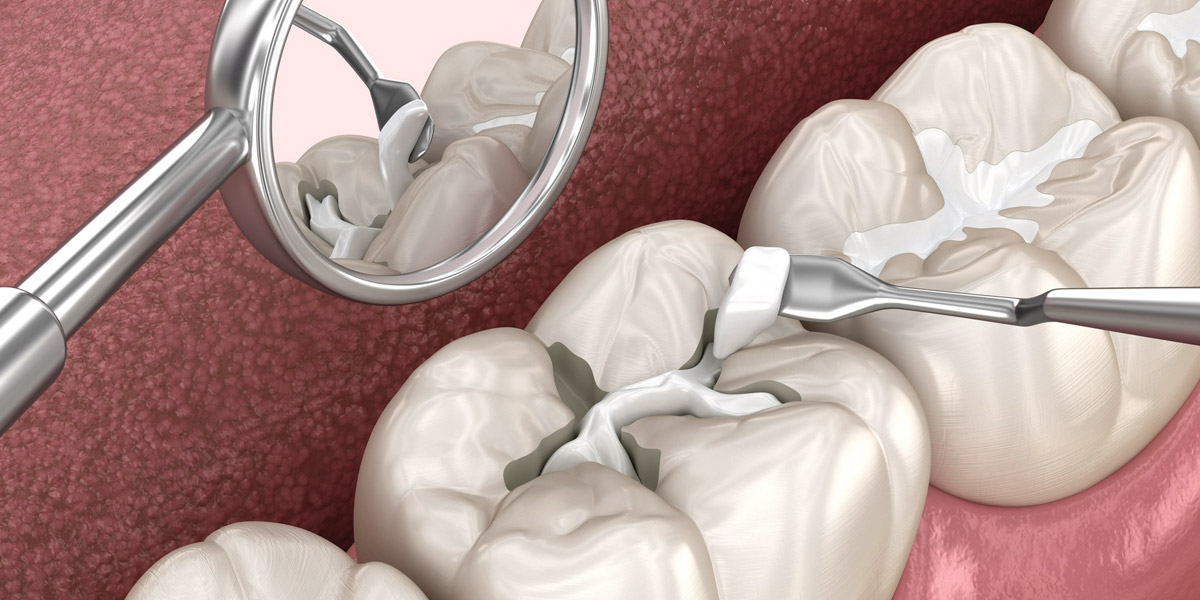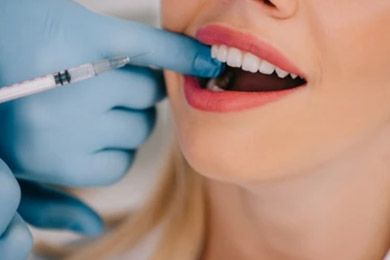Dental filling is one of the most basic treatment methods of dentistry. It is a preventive treatment that provides elimination of the problem before it grows. If dental filling is poorly done, you may encounter serious trouble without noticing it.
When teeth have lost material due to various reasons, they are treated with dental filling. Dental caries is the most common cause of material loss in teeth. Especially bacteria found in sugary and carbohydrate-containing foods produce an acid that causes tooth decay. This acid damages the tooth enamel and causes dental caries. At first, the decay appears as opaque white lesions. This is the initial stage of caries and is called white spot lesion. As the caries progresses, it causes a yellow to brown discolouration and cavity. Caries that have not reached the vital part of the tooth can be treated with dental fillings.
Teeth may chip or crack as a result of acute or chronic trauma. Cracked and chipped teeth may cause hot-cold sensitivity. It may cause pain while eating sugar contained foods or chewing. Teeth can be treated with dental filling depending on the size of the fractured area.
Wear can be seen on the chewing surface of the teeth due to clenching, which is called abrasion. Another condition clenching may cause chipping of the thin enamel presents close to the gums. This is known as attrition. Attrition can also occur as a result of too hard brushing.
In cases where teeth are deformed, dental filling treatment can be applied to idealise the aesthetic function. The upper side incisors are most commonly deformed and this condition is mostly genetic. Febrile diseases in childhood, misuse of medication, traumas and dental infections can cause shape and colour disorders in permanent teeth. This kind of tooth with structural defects usually has a yellow-brown colour. Sometimes there may be cavities on the teeth in the form of dots or larger cavities. The enamel is very weak and has the potential for decay and fracture. Dental filling treatment can be applied both to increase the strength of the tooth and to improve its aesthetics.
It is the removal of decayed or damaged tissue in the tooth and replacing it with a biocompatible filling material. This treatment prevents the progression of caries. Thus, dental health is protected without the need for treatments such as root canal treatment, dental crowns or tooth extraction.
Composite fillings are mostly preferred in treatments currently. It is generally known as white filling. Composite fillings are durable and aesthetic because they are tooth-coloured. Another advantage of composite fillings are that they are chemically bonded to the tooth surface and provides high retention. Thus, unlike amalgam fillings, it provides less loss of healthy tooth tissue.
Amalgam fillings were frequently preferred for many years before composite fillings. They are very strong. Since they are held by mechanical connection, it is often necessary to remove the healthy tooth surface together with the decay during application. It is not preferred today. It is not aesthetic because its colour is black. Although studies on the mercury content and risks of amalgam fillings have not been completed, it may cause health concerns.
Ceramic fillings are very aesthetic. It has the highest durability compared to other filling materials. It needs two visits to be made. After cleaning the decay, the dentist takes a tooth impression and creates a request for the filling to be produced in the laboratory. In the second visit, the treatment is completed by applying it to the patient's mouth. It is more costly than other treatment methods.
Temporary fillings, as the name suggests, are fillings that cannot stay in the mouth for a long time. They are flimsy, easily worn and cracked. They are generally used in the process of root canal treatments that require several visits, during the production stage of inlay & onlay fillings, after emergency intervention to painful patients, or when a permanent filling cannot be made in a single session. It should be used within the period recommended by the dentist. It is a temporary solution, the dentist should be visited to complete the treatment.
New fillings may fall out if they are not made in accordance with the procedure. In addition, traumas caused by impact or traumas caused by chewing such as biting hard objects can cause fillings to fall out. In these cases, the dentist should be visited immediately.
Chewing, grinding and clenching of teeth may cause the filling to wear and crack. Generally, patients may not realise that their fillings are worn and cracked. Therefore, regular visits to the dentist are recommended.
Composite fillings may become coloured over time due to reasons such as water absorption and consumption of colouring foods. Especially the colouring of the fillings in the anterior region may cause aesthetic concerns. In such cases, the filling is polished or renewed.
It is normal to have sensitivity for a while after filling, but if the sensitivity lasts too long, it signifies the presence of an unfavourable situation. If the sensitivity lasts longer than 3-4 weeks, do not neglect to visit the dentist.
If the sensitivity of the filled tooth is very severe or the pain continues, root canal treatment may be required. If it is not treated, the tooth may need to be extracted.
If the filling is not done in an appropriate way or if it is broken at the edge, bacteria can leak between the tooth and the filling. In this case, the tooth continues to decay under the filling. It is very difficult to diagnose with the naked eye, but dentists can recognise it from the X-ray image. Therefore, the dentist should be visited regularly. If you feel pain in your previous filling, you should consult a dentist. In case of bacterial leakage, the filling should be renewed. In cases where the decay is very advanced, canal treatment or tooth extraction may be required.
If the filling is too large, it may be prone to fracture because the tooth tissue surrounding the filling is thin. In such cases, the tooth is usually broken, not the filling material. If there is a lot of material loss in the tooth due to fracture, the tooth may not be restored and needs to be extracted. For this reason, it is important to avoid biting very hard objects in the areas with large fillings. If your dentist recommends veneer treatment for the relevant tooth, it should be considered.
Dental filling prices in Turkey can be comparatively cheap. Our mini price list includes prices for dental fillings and related treatments. Please check it out.
| Dental Treatment Prices in Turkey | |
|---|---|
| Consultation | Free |
| Panaromic X-ray | Free |
| Examination | Free |
| Local Anesthesia | Free |
| Composite Dental Filling (a face) | £ 48 |
| Composite Dental Filling (2-3 faces) | £ 60 |
| Root Canal Treatment (dental filling is included) | £ 150 |
| Dental Inlay & Onlay (ceramic) | £ 175 |
| Metal Porcelain Crown (per tooth) | £ 130 |
| Zirconium Crown (per tooth) | £ 195 |
| emax Crown (per tooth) | £ 325 |
There are some points to be considered for ideal healing after dental fillings;
Firstly, a detailed oral examination and X-ray examination is performed. Decayed teeth are identified. The dentist decides on the treatment according to the size and depth of the decay. If the decay is very large, he/she recommends canal treatment or crown treatment.
Local anaesthesia is used to numb the operation area so that no pain is felt during the procedure.
The decayed or damaged tissue is removed with dental instruments.
After the decayed or damaged tissue has been completely removed, the dentist performs some procedures to make the surface free of bacteria and suitable for adhesion. At this point, it is important that saliva or any foreign particles do not come into contact with the cavity. Your dentist can use dental cotton roll or rubberdam for isolation. The dentist may use additional protective material if the decay is too close to the living tissue of the tooth that is called the pulp. The tooth is dried and the bonding agent is applied. Then composite filling material is placed layer by layer.
Filling material is strengthened with dental curring light. Afterwards, the bite is controlled and the excess is removed. The treatment is terminated by applying polish.
There are some points to be considered for ideal healing after dental fillings. You should read them in this article as above.
We do our best to ensure that our patients' dental treatments are comfortable. Keeping their satisfaction at the highest level is very important to us.
Please fill the form, we will contact to you for online dental consultation.
Please fill the form, we will contact to you for online dental consultation.










